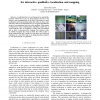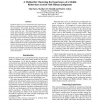80 search results - page 1 / 16 » A Semi-supervised Method for Learning the Structure of Robot... |
CVPR
2006
IEEE
14 years 6 months ago
2006
IEEE
We consider the general problem of learning from both labeled and unlabeled data. Given a set of data points, only a few of them are labeled, and the remaining points are unlabele...
IDA
2003
Springer
13 years 9 months ago
2003
Springer
For a mobile robot to act autonomously, it must be able to construct a model of its interaction with the environment. Oates et al. developed an unsupervised learning method that pr...
HRI
2006
ACM
13 years 10 months ago
2006
ACM
The essence of the signal-to-symbol problem consists of associating a symbolic description of an object (e.g., a chair) to a signal (e.g., an image) that captures the real object....
ICRA
2007
IEEE
13 years 11 months ago
2007
IEEE
— Localization for low cost humanoid or animal-like personal robots has to rely on cheap sensors and has to be robust to user manipulations of the robot. We present a visual loca...
AAAI
2000
13 years 6 months ago
2000
If robotic agents are to act autonomously they must have the ability to construct and reason about models of their physical environment. For example, planning to achieve goals req...



